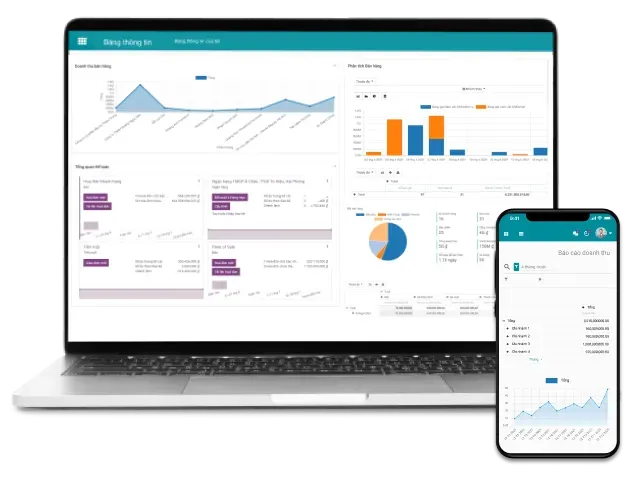Complying with International accounting standards (IFRS) such as IFRS 16 is essential for maintaining transparency and trust in financial reporting. IFRS 16 software not only helps businesses accurately recognize lease assets and liabilities but also optimizes the asset leasing accounting process. Viindoo, with its advanced features and user-friendly interface, offers the perfect solution to help your company easily manage and comply with IFRS 16 regulations. Let’s explore how Viindoo can enhance the efficiency of your asset leasing accounting!
Lease accounting under IFRS 16
Overview of IFRS 16 Requirements
IFRS 16, which came into effect on January 1, 2019, requires businesses to recognize all lease contracts on their balance sheets, regardless of the type of lease. This means that companies must record leased assets as assets and lease obligations as liabilities. The primary aim of this standard is to enhance transparency and reliability in financial reporting by providing a clearer picture of a company’s financial position. Specifically, businesses need to determine the lease term, calculate the present value of lease payments, and consider other relevant factors to accurately assess the value of the related assets and obligations.
Differences between IFRS 16 and previous accounting standards
Before IFRS 16 was introduced, accounting standards like IAS 17 classified lease contracts into two categories: finance leases and operating leases. While finance leases required the recognition of both assets and liabilities on the balance sheet, operating leases often went unrecognized, leading to a lack of information in financial reports. For example, a business could lease a piece of machinery without recording it as an asset, which might make the financial situation appear better than it actually is. With IFRS 16, all lease contracts, including operating leases, must be recognized, creating a clearer and more accurate financial picture of the company's assets and liabilities. This not only improves transparency but also helps investors and stakeholders more accurately assess the financial health of the business.

IFRS 16 requires businesses to recognize all lease contracts on their balance sheets
Challenges in implementing IFRS 16
Businesses often struggle with identifying and classifying lease contracts under IFRS 16. Reviewing numerous leases to determine compliance is complex and time-consuming. Companies need a clear process to collect and analyze relevant information, such as lease terms and payment conditions. Additionally, calculating the present value of lease payments requires a robust data management system to ensure accuracy.
To comply with IFRS 16, businesses must establish an effective lease management system to track and update contract information, including changes and associated costs. Training accounting staff on IFRS 16 requirements is essential to ensure accurate reporting and awareness of accounting standards. Finally, companies should conduct internal audits and regular evaluations to maintain compliance with IFRS 16.

To comply with IFRS 16, businesses must establish an effective lease management system
Viindoo solutions for Lease Accounting under IFRS 16
Implementing IFRS 16 presents various challenges for businesses, including identifying lease contracts and managing complex information related to liabilities and leased assets. These issues can result in inaccuracies in financial reporting if not addressed promptly. Viindoo offers robust solutions that automate the recording and management of lease contracts, enabling businesses to efficiently track and update critical information. With its advanced features, Viindoo empowers organizations to navigate these challenges effectively while optimizing their accounting processes and enhancing overall operational efficiency.
Key Features of Viindoo in Lease Accounting According to IFRS 16
For Lessees
- Recording Lease Liabilities: Viindoo allows businesses to record the initial value of lease liabilities. After initial recognition, companies can record interest expenses on the remaining balance, any variable lease payments, and lease liabilities that have been paid. This feature ensures accuracy in financial reporting while minimizing the risk of errors when determining lease liabilities at the reporting date, a common challenge for many businesses implementing IFRS 16.
- Recording Right-of-Use Assets: The software enables the recording of the initial value of right-of-use assets and subsequent adjustments according to the cost model. Viindoo supports cumulative depreciation and impairment losses, while also allowing value adjustments when lease liabilities are reassessed. This helps businesses manage their assets effectively, addressing the difficulty of maintaining accuracy and transparency in financial reporting.
For Lessors
- Accounting for Lease Assets: Viindoo provides a solution for recording the value of finance lease assets, allowing businesses to recognize financial revenue (lease interest) periodically and accurately account for received lease payments. This feature gives lessors a clear view of their revenue, supporting financial planning and effective cash flow management.
- Accounting for Operating Leases: The software facilitates accounting transactions and asset management for operating leases. Viindoo allows for the recognition of initial direct costs incurred to obtain lease agreements in the carrying amount of the underlying asset and recognizes lease payments as revenue from operating leases when they are due. This helps businesses address the challenge of accurately aggregating costs and revenues, ensuring transparency and efficiency in financial reporting.

Viindoo not only meets the requirements of IFRS 16 but also helps businesses optimize asset management processes
Benefits of using Viindoo to Accounting lease according to IFRS
Utilizing Viindoo for lease accounting under IFRS offers significant advantages for businesses. The software streamlines the process of recording lease liabilities and right-of-use assets, ensuring compliance with IFRS requirements. By providing detailed tracking of lease agreements, companies can efficiently manage costs, rental income, and asset status, which enhances financial transparency. Viindoo’s automated features reduce the risk of errors, allowing for accurate financial reporting and informed decision-making. Ultimately, adopting Viindoo not only simplifies compliance with IFRS but also optimizes asset management processes, leading to improved operational efficiency and better financial outcomes.

The automated features of Viindoo help businesses minimize the workload of accounting for lease assets according to IFRS.
Conclusion
IFRS 16 software plays a crucial role in transforming how businesses manage their lease accounting. With Viindoo, businesses can streamline their processes, ensuring compliance with IFRS 16 while improving accuracy and efficiency. The software's automated features simplify the recording of lease liabilities and right-of-use assets, allowing businesses to focus on strategic decision-making rather than manual data entry. By leveraging Viindoo, companies not only enhance their financial transparency but also optimize asset management, ultimately leading to better operational performance and financial outcomes. Embracing Viindoo for lease accounting is a vital step toward a more efficient and compliant financial future.
FAQs
Under the lessee accounting model under IFRS 16, there is no longer a classification distinction between operating and finance leases. Instead, a single model approach now exists whereby all lessee leases post-adoption are reported as finance leases.
IFRS 16 introduces a single lessee accounting model and requires a lessee to recognise assets and liabilities for all leases with a term of more than 12 months, unless the underlying asset is of low value.
According to IFRS 16, the lease liability value is calculated with the following formula: The present value of the lease payments payable over the lease term. Discounted at the rate implicit in the lease